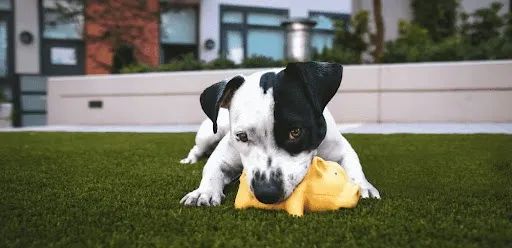
How to Clean Artificial Grass from Dog Urine? Step-By-Step Guide
October 26, 2023
by jacob kay, guest contributor
Artificial grass has become a popular landscaping choice for many homeowners, offering the allure of a pristine green lawn without the hassle of constant maintenance. For pet owners, it's a particularly attractive option, as it provides a durable and pet-friendly surface that dogs can romp and play on.
However, one inevitable challenge that comes with owning a furry friend is dealing with their "business" on your pristine artificial lawn. If you're wondering how to keep your synthetic turf clean and odor-free, you've come to the right place.
In this step-by-step guide, we'll explore the best methods to clean artificial grass from dog urine, ensuring your outdoor space remains beautiful, fresh, and inviting. Say goodbye to unsightly yellow patches and unpleasant odors as we walk you through the process of maintaining your artificial lawn.
The Problem of Dog Urine on Artificial Grass
Dog urine contains urea, ammonia, and uric acid, which are all acidic substances that can harm artificial grass. Urea and ammonia can cause discoloration and fading of the grass blades, while uric acid can crystallize and form hard deposits that can clog the drainage holes and reduce the permeability of the turf.
Moreover, dog urine can create unpleasant odors that can linger on the grass and attract more dogs to urinate on the same spot. Using the best artificial grass cleaner for dog urine can help remove stains and neutralize odors.
If left untreated, dog urine can also pose health risks for both humans and pets. Dog urine can harbor bacteria, viruses, parasites, and fungi that can cause infections, allergies, or diseases.
For example, dog urine can transmit leptospirosis, a bacterial infection that can affect the kidneys and liver of both dogs and humans. Therefore, it is essential to clean artificial grass from dog urine regularly to prevent these problems and keep your lawn looking and smelling fresh.
How to Clean Dog Urine on Artificial Grass: Step-by-step Guide
Cleaning artificial grass from dog urine is not a difficult task if you follow these steps:
- Blot up the urine with paper towels as soon as possible. This will help absorb most of the liquid and odor from the grass before it seeps into the backing or the soil underneath. Use enough paper towels to cover the affected area and press firmly to soak up as much urine as you can. Discard the paper towels in a trash bin or a compost pile.
- Rinse the area with clean water. Use a hose or a bucket to spray or pour water over the spot where your dog urinated. This will help flush out any remaining urine and dilute its acidity. Make sure the water drains well through the turf and does not pool on the surface or create mud underneath.
- Apply a commercial cleaner or a homemade solution to neutralize the odor and disinfect the grass. There are many products available in the market that are specially designed for cleaning artificial grass from dog urine. These products usually contain enzymes, bacteria, or ion-based compounds that can break down the organic matter and eliminate the odor-causing molecules in dog urine.
You can also make your own solution by mixing equal parts of water and vinegar, which is a natural deodorizer and disinfectant. Follow the instructions on the product label or spray bottle and apply the cleaner or solution generously over the area. Let it sit for a few minutes or as long as recommended by the manufacturer.
- Rinse again with water. After applying the cleaner or solution, rinse the area again with water to remove any residue or excess product. Make sure the water drains well and does not leave any soap or vinegar behind.
- Dry the area with a towel or a blower. Use a clean towel or a blower to dry the area thoroughly. This will help prevent mold or mildew growth on the grass or the backing. It will also make the grass more comfortable for your dog to walk or lie on.
- Repeat as needed until the odor is gone. Depending on how strong or persistent the odor is, you may need to repeat these steps more than once until you are satisfied with the results. You can also use a sniff test to check if there is any remaining odor on the grass.
How to Prevent Dog Urine from Damaging Artificial Grass
Cleaning artificial grass from dog urine is important, but prevention is better than cure. Here are some tips on how to prevent dog urine from damaging artificial grass in the first place:
- Train your dog to use a designated area for urination. You can create a separate area for your dog to pee on by using gravel, sand, wood chips, or real grass. This will help protect your artificial grass from frequent exposure to urine and make it easier for you to clean up after your dog.
- Encourage your dog to drink more water. Water helps dilute the concentration of urine and reduce its acidity and odor. It also helps flush out toxins from your dog's body and keep them hydrated and healthy.
- Adjust your dog's diet if necessary. Some foods can make your dog's urine more acidic or alkaline, which can affect its smell and impact on artificial grass.
For example, foods high in protein, such as meat, eggs, or cheese, can increase the acidity of urine, while foods high in calcium, such as dairy products, bones, or supplements, can increase the alkalinity of urine. You can consult your veterinarian for advice on the best diet for your dog and their urinary health.
- Clean your artificial grass regularly. Even if your dog does not urinate on your artificial grass, you should still clean it regularly to remove any dirt, dust, pollen, or other contaminants that can accumulate on the surface or in the backing.
You can use a broom, a rake, a vacuum, or a blower to remove any solid debris, and a hose or a sprinkler to rinse the grass with water. You can also use a mild detergent or a commercial cleaner to sanitize and deodorize the grass once in a while.
Well, That’s a Wrap
Maintaining the beauty and freshness of your artificial grass in the face of dog urine might seem like a daunting task, but with the right steps and consistent care, you can keep your outdoor space looking and smelling its best.
By following the guidelines provided in this step-by-step guide, you can effectively clean and neutralize dog urine, preventing unsightly stains and unpleasant odors from taking over your pristine lawn.
Remember, the key to success is regular maintenance and swift action. Whether you opt for natural or commercial cleaning solutions, a diligent cleaning routine, and proper drainage systems, your artificial grass can remain an enjoyable, pet-friendly oasis for both you and your four-legged companions.
So, don't let the fear of dog urine deter you from enjoying your beautiful, low-maintenance yard. With the right knowledge and a commitment to cleanliness, you can have it all - a perfect lawn and a happy, healthy dog.
Guest Writer
Jacob Kay is a dedicated Veterinary Advisor and Editor at WWD, whose passion for dogs extends beyond his professional life. With two cherished canine companions of his own, he brings a wealth of knowledge in the realm of veterinary medicine to the forefront. Jacob's writing delves into essential topics like selecting the ideal diet for your dog and ensuring their ongoing health and happiness. His expertise isn't limited to nutrition; he offers valuable counsel on various aspects of dog care, including exercise, well-being, and safety. Jacob Kay is a fervent advocate for spaying and neutering, firmly believing in its pivotal role in diminishing the population of homeless animals.
Guest writers are an important part of Simply Family Magazine. Do you want to write for us? Click here!





